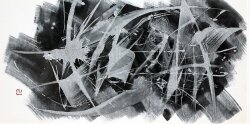Meaningful gestures: Maeda reveals a playful heart
An old theater exercise has actors repeat a short sentence over and over, each time emphasizing a different word to shift the sentence’s meaning and impact. Japanese calligraphy artist Noriko Maeda takes a similar approach on the visual plane, painting the same Kanji character again and again, varying the quality of her marks to express different nuances of the word.
Most viewers of Maeda’s current Warm Springs Gallery exhibition, “Asobu: To Play Like a Child,” won’t know Japanese, but they can nevertheless appreciate her technical skill and the freedom and energy she brings to her paintings. Maeda is the perfect example of an artist who has mastered the rules of her chosen medium and then let the restrictions go to achieve something more meaningful than literal meaning.
In the current exhibit, she offers two variations of the character “kokoro,” Japanese for “heart,” as well as numerous interpretations of “asobu,” most commonly translated as “to play,” but which carries connotations of liberation, independence, and even sexual pleasure. Using sumi ink on washi, a traditional handmade paper, Maeda produces different effects by changing the amount of ink on her brush, the speed and pressure of her strokes, the placement of the character on the page, the size of the image, etc. Sometimes she gives the character a “shadow,” by repeating it off to one side in a diluted gray, which makes the darker strokes jump to the foreground while the paler ones float in the background.
Another Maeda technique involves painting the character and other brushwork in a colorless gel, which only becomes visible when she flips the paper and paints the back with ink, which the gel resists. The complementary dynamism of sweeping inky diagonal brushstrokes and Maeda’s frenetic negative-space strokes is especially compelling in the large horizontal piece, “Play Like a Child.”
Maeda takes what already appear to non-Japanese speakers to be abstract paintings into the realm of pure abstraction in six square works hanging on the gallery’s back wall. Here Maeda has excerpted areas driven solely by visual energy from a larger calligraphic painting, putting aside linguistic meaning altogether. The visceral impact of these “Play Fragments” provides an intriguing contrast with her more traditional work, exemplified by four seasonal variations of a poem by Ono no Kamachi.
No language skills are necessary to understand the power of Maeda’s playful brushwork and her informed yet free approach to making meaning.
Noriko Maeda’s exhibition, “Asobu: To Play Like a Child,” is on view through September 30 at Warm Springs Gallery, 105 Third St. NE. 245-0800.
